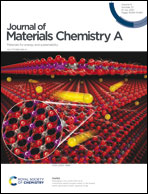Recent advancements in solid electrolytes integrated into all-solid-state 2D and 3D lithium-ion microbatteries
Abstract
With the increasing role of microelectronics and autonomous wireless devices in everyday life, the miniaturization of power sources has attracted a lot of attention. Solid-state Li-ion microbatteries proved to be a good candidate for micro-energy storage devices due to their high energy density. As the electrolyte is one of the key components in a battery, much research has been conducted to develop high-quality materials for successful integration in the microbattery technology. Several types of solid electrolytes, including inorganic glass, crystalline and polymer materials, have been investigated in both two-dimensional (2D) and three-dimensional (3D) architecture, and these systems are reviewed in this work along with the general overview of microbatteries concepts. The latest advancements, performance and remaining issues of both 2D and 3D solid structures with different solid electrolytes are discussed. The paper also focuses on reviewing the electrochemical properties of solid electrolytes reported in various literature. So far, it was observed that LiPON electrolyte satisfying most of the electrolyte specifications appears to be one of the most studied and the most appropriate candidates for solid-state microbatteries, performing well in several 2D and innovative 3D structures. Along with that, polymer electrolytes with innovative 3D architectures deposited with effective techniques, such as electrodeposition, formed an excellent electrode–electrolyte interface and showed high power and energy densities. Therefore, these electrolytes hold great promise for further 3D microbatteries development. The important information on solid electrolytes and their application in microbatteries is systemized and provided, including the electrolyte composition, ionic conductivity, microbattery electrodes, preparation methods and conditions, architecture, electrochemical test conditions and their performance to elucidate the electrolyte candidates and their microbattery structures with high capacity and long cycle life.



 Please wait while we load your content...
Please wait while we load your content...